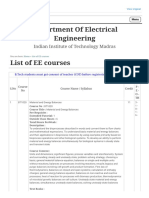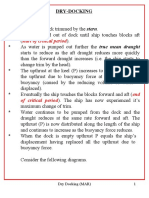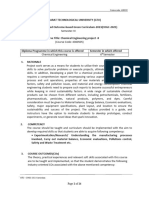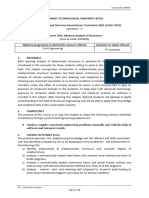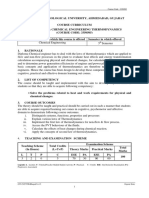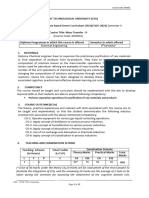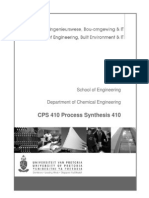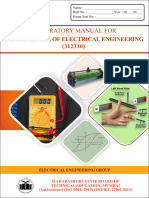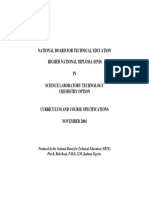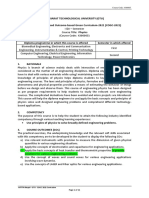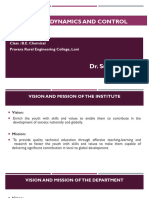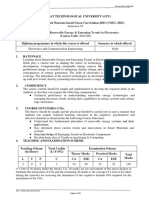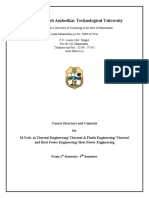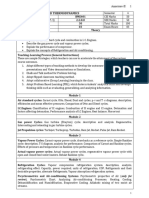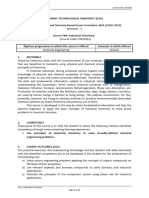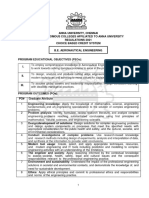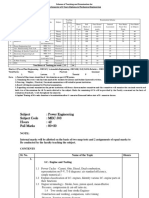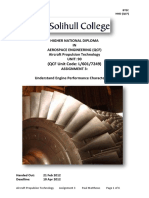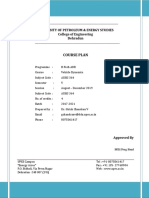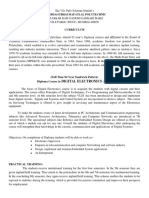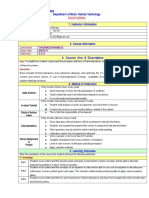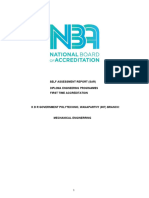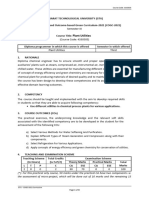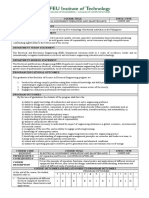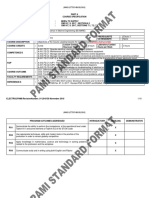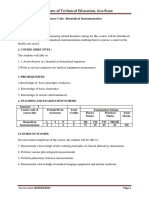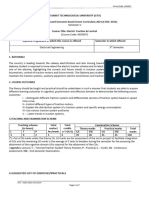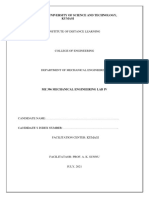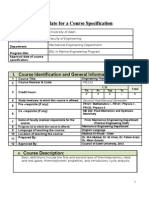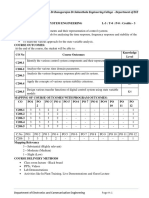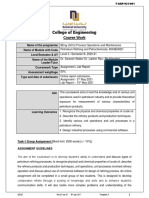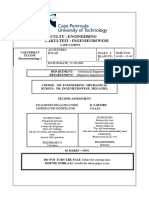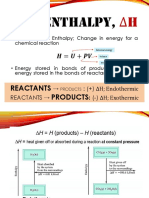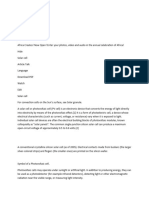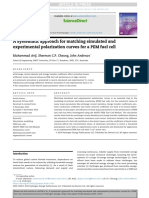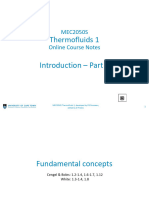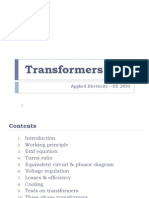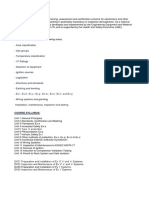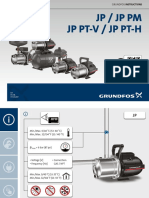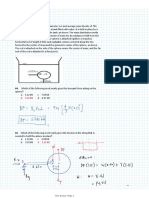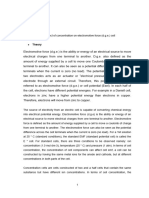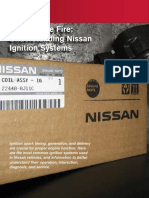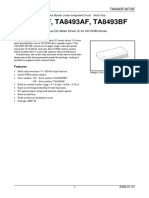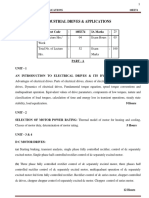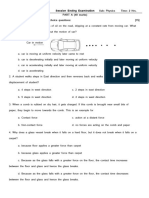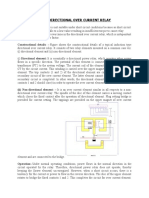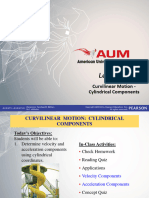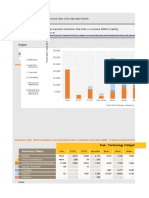Chemical Engineering Thermodynamics Subject Code: 4340503
Chemical Engineering Thermodynamics Subject Code: 4340503
Uploaded by
Solanki DarshitOriginal Description:
Original Title
Copyright
Available Formats
Share this document
Did you find this document useful?
Is this content inappropriate?
Report this DocumentCopyright:
Available Formats
Chemical Engineering Thermodynamics Subject Code: 4340503
Chemical Engineering Thermodynamics Subject Code: 4340503
Uploaded by
Solanki DarshitCopyright:
Available Formats
Chemical Engineering Thermodynamics Subject Code: 4340503
GUJARAT TECHNOLOGICAL UNIVERSITY (GTU)
Competency-focused Outcome-based Green Curriculum-2021(COGC-2021)
Semester-IV
Course Title: Chemical Engineering Thermodynamics
(Code: 4340503)
Diploma Programme in which this course is offered Semesterinwhichoffered
Chemical Engineering Thermodynamics 4th Semester
1. RATIONALE
Diploma Chemical engineer has to deal with the laws of thermodynamics which are
applied to flow and non-flow processes in the plant to evaluate heat effects and energy
transformation calculation accompanying physical and chemical changes, for calculating
temperature change and to determine power generation efficiencies of engines and
power plants. Understanding of basic concepts and application of thermodynamics are
therefore necessary for chemical engineers. Hence the course has been designed to
develop these competencies and its associated cognitive and effective domain learning
outcomes.
2. COMPETENCY
The aim of this course is to help the student to attain the following industry identified
competency through various teaching learning experiences:
Solve the problems related to heat and work requirements for physical and chemical
changes.
Identify the various phase behavior of different fluids.
Explain the working principles of heat engine, heat pump and refrigeration and
calculate efficiency
3. COURSE OUTCOMES(COs)
The theory, practical experiences and relevant soft skills associated with this course are
to be taught and implemented, so that the student demonstrates the following industry-
oriented COs associated with the above-mentioned competency:
1. Understand the fundamental concepts of thermodynamics
2. Apply the Concept of First Law of Thermodynamics for flow and non-flow processes.
3. Use the equation of state for ideal gas and real gas to predict PVT behavior of fluid.
4. Apply the Concept of second Law of Thermodynamics.
5. Apply the laws of thermodynamics in refrigeration
GTU - COGC-2021 Curriculum
Page 1 of 9
Chemical Engineering Thermodynamics Subject Code: 4340503
4. TEACHING AND EXAMINATION SCHEME
Teaching Scheme Total Examination Scheme
(In Hours) Credits(L+T+P) Theory Marks Practical Marks Total
Marks
L T P C CA ESE CA ESE
3 - - 3 30* 70 - - 100
(*):Out of 30 marks under the theory CA,10 marks are for assessment of the micro-project
to facilitate the integration of COs, and the remaining 20 marks are the average of 2 tests
tobe taken during the semester for assessing the attainment of the cognitive domain UOs
required for the attainment of the COs.
Legends: L-Lecture; T – Tutorial/Teacher Guided Theory Practice; P - Practical; C – Credit,
CA -Continuous Assessment; ESE-End Semester Examination.
5. SUGGESTED PRACTICAL EXERCISES
The following practical outcomes (PrOs) are the sub-components of the COs. Some of the
PrOsmarked ‘*’ (in approx. Hrs column) are compulsory, as they are crucial for that
particular CO at the ‘Precision Level’ of Dave’s Taxonomy related to ‘Psychomotor Domain’.
Sr. Practical/Exercise (Course Outcomes in Psychomotor Unit No. Approx.
No. Domain according to NBATerminology) Hrs Required
Not Applicable
Note
i. More Practical Exercises can be designed and offered by the respective course teacher to
develop the industry relevant skills/outcomes to match the COs. The above table is only a
suggestive list.
ii. The following are some sample ‘Process’ and ‘#Product’ related skills (more may be
added/deleted depending on the course) that occur in the above listed Practical Exercises of
this course required which are embedded in the COs and ultimately the competency.
Sr. No. Sample Performance Indicators for the PrOs Weightage in %
1 Question answer or Writing steps exercise (Assignment) 30
2 Executing of exercise 30
3 Result 40
Total 100
6. MAJOR EQUIPMENT/INSTRUMENTS AND SOFTWARE REQUIRED
These major equipment/instruments and Software required to develop PrOs are given
below with broad specifications to facilitate procurement of them by the
administrators/management of the institutes. This will ensure the conduction of practice in
all institutions across the state in a proper way so that the desired skills are developed in
students.
GTU - COGC-2021 Curriculum
Page 2 of 9
Chemical Engineering Thermodynamics Subject Code: 4340503
Sr. No. Equipment Name with Broad Specifications PrO. No.
Not Applicable
7. AFFECTIVE DOMAIN OUTCOMES
The following sample Affective Domain Outcomes (ADOs) are embedded in many of the
above-mentioned COs and PrOs. More could be added to fulfill the development of
thiscompetency.
a) Work as a leader/a team member.
b) Follow ethical practices
c) Observe safety measures
d) Good house keeping
e) Time management
f) Practice environmentally friendly methods and processes.
The ADOs are best developed through laboratory/field-based exercises. Moreover, the level
of achievement of the ADOs according to Krathwohl’s ‘Affective Domain Taxonomy’ should
gradually increase as planned below:
i. ‘Valuing Level’ in 1st year
ii. ‘Organization Level’ in 2nd year.
iii. ‘Characterization Level’ in 3rd year.
8. UNDERPINNING THEORY
The major underpinning theory is given below based on the higher level UOs of Revised
Bloom’s taxonomy that are formulated for development of the Cos and competency. If
required, more such higher-level UOs could be included by the course teacher to focus on the
attainment of COs and competency.
Major Learning Outcomes (Course
Unit Outcomes in Cognitive Domain Topics and Sub-topics
according to NBA terminology)
Unit– I 1a. Describe scope of 1.1 Scope and limitations of
Introduction thermodynamics thermodynamics
1b.Explain the System, 1.2 System, surrounding, functions,
and Basic
surrounding, and properties properties and Process
Concept 1.2.1 System-Homogeneous and
with examples of chemical
engineering field heterogeneous, Closed and
Open, Isolated System, State of
System
1c. Differentiate functions, 1.3 Properties -Extensive and
properties and intensive
processes 1.4 Function -State and Path function
1.5 Process -Reversible and
irreversible process, cyclic
process
GTU - COGC-2021 Curriculum
Page 3 of 9
Chemical Engineering Thermodynamics Subject Code: 4340503
1d. Explain type of equilibrium 1.6 Steady and Equilibrium State
for the given system 1.7 Thermal, Chemical, Mechanical
and thermodynamic equilibrium
1e. Explain 1.8 Force, Pressure, Work, powerand
importantphysical Energy
quantities
1f. Explain Phase Rule 1.9 Gibb’s Phase rule, degree of
freedom
1g. Explain Temperature and 1.10 Zeroth Law of thermodynamics
Zeroth Law of 1.11 Temperature
thermodynamics 1.12 Ideal Gas Temperature Scale
1h. Solve simple numerical 1.13 Simple examples (numerical)on
Force, Pressure, Work and Energy
phase rule
Unit– II 2a. Explain first law and 2.1 First law of thermodynamics
First Law energy - Internal Energy, 2.2 Internal Energy, Enthalpy and
of Enthalpy and Heat Heat capacity
capacity concepts with 2.3 First law for non-flow processes
Thermody
examples of chemical and flow processes of chemical
namics engineering engineering
2b. Apply first law for non-
flow & flow process of
chemical engineering
2c. Solve simple numerical 2.4 Numerical basedon first law and
energy - Internal Energy, Enthalpy
and Heat capacity
Unit– III 3a. Explain PVT behavior of pure 3.1 PVT behavior of pure fluids
PVT fluids
Behavior 3b. Explain Ideal gas Processes 3.2 Ideal gas and equation of state
3.3 Ideal gas Process:
3.3.1 Constant Volume process
3.3.2 Constant Pressure process
3.3.3 Constant Temperature process
3.3.4 Adiabatic Process
3.3.5 Polytropic Process
3c. Compare equations of 3.4 Equation of state for real gases
state for real gases 3.4.1 Vander Waals Equation
3.4.2 Virial Equation
3.4.3 Compressibility charts
3d. Solve simple numerical 3.5 Numerical based on Idea gas and
real gas equations
Unit–IV 4a. Discuss limitation of first 4.1 Limitations of first law of
Second Law law thermodynamics
Of
4b. Describe the concepts of 4.2 Heat reservoir, Heat engine and Heat
Thermo- Heat reservoir, Heat engine pump
dynamics and Heat pump
4c. State different statements of 4.3 Clausius Statement
Second law 4.4 Kelvin Planck Statement
GTU - COGC-2021 Curriculum
Page 4 of 9
Chemical Engineering Thermodynamics Subject Code: 4340503
4d. Explain Carnot cycle, carnot 4.5 Carnot cycle and thermodynamic
principle and temperature scale
thermodynamic temperature
scale
4e. Explain Concept of Entropy 4.6 Concept of Entropy
for the given system 4.7 Mathematical Expression of
entropy
4f. Calculate entropy change 4.8 Calculation of entropy changes
during:
4.8.1 phase change,
4.8.2 ideal gas process
4.8.3 adiabatic mixing process,
4.8.4 isothermal mixing of ideal gases,
4.8.5 chemical reaction
4g. Solve Numerical 4.9 Numerical based on entropy
change and heat engine efficiency
4h. Explain Third Law of 4.10 Explain the Statement of Third Law
thermodynamics. of thermodynamics
Unit– V 5.1 Explain refrigeration, COP,
Refrigeration 5a. Refrigeration Cycles and Refrigerator capacity
Cycles and Systems
5b. Describe various refrigeration 5.2 Vapor-compression cycle and Air-
Systems cycles refrigeration cycle (only theory)
5c. Explain various types of 5.3 Types of refrigerants and codes
Refrigerants and their codes 5.4 Choice of refrigerant
5d. Solve Numerical 5.4 Numerical based on CoP,
Refrigerator Capacity
9. SUGGESTED SPECIFICATION TABLE FOR QUESTION PAPER DESIGN
Distribution of Theory Marks
Teaching R U A Total
Unit Unit Title Level Level Level Marks
Hours
Introduction and
I 09 06 04 03 13
Basic Concepts
II First Law of 09 03 04 06 13
Thermodynamics
III PVT behavior 09 04 06 06 16
IV Second Law of 10 05 07 06 18
Thermodynamics
V Refrigeration Cycles and 05 03 04 03 10
Systems
Total 42 21 25 24 70
GTU - COGC-2021 Curriculum
Page 5 of 9
Chemical Engineering Thermodynamics Subject Code: 4340503
Legends: R=Remember, U=Understand, A=Apply and above (Revised Bloom’s taxonomy)
Note: This specification table provides general guidelines to assist students for their
learningand to teachers to teach and question paper designers/setters to formulate test
items/questionsto assess the attainment of the UOs. The actual distribution of marks at
different taxonomy levels (of R, U and A) in the question paper may slightly vary from
above table.
10. SUGGESTED STUDENT ACTIVITIES
Other than the classroom and laboratory learning, the following are the suggested
student-related co-curricular activities which can be undertaken to accelerate the
attainment of the various outcomes in this course: Students should perform the following
activities in group and prepare small reports of about 5 pages for each activity. They
should also collect/recordphysical evidence such as photographs/videos of the activities
for their (student’s) portfolio which will be useful for their placement interviews:
a) Prepare the presentation on various topics of thermodynamics
b) Practice various different free available thermodynamic simulation tools.
c) Prepare Chart/Poster on PVT diagram
d) Identify different refrigerants
11. SUGGESTED SPECIAL INSTRUCTIONAL STRATEGIES (if any)
These are sample strategies, which the teacher can use to accelerate the attainment of
the various outcomes in this course:
a) Massive open online courses (MOOCs) may be used to teach various topics/subtopics.
b) Guide student(s) in undertaking micro-projects/activities.
c) Different types of teaching methods i.e. video demonstration, activity based learning,
case study, m-learning need to be employed by teachers to develop the outcomes.
d) Some of the topics/sub-topics which is relatively simpler or descriptive are to be given
to the students for self-learning but to be assessed using different assessment
methods.
e) Teachers need to ensure to create opportunities and provisions for co-curricular
activities.
f) Guide students to address issues on environment and sustainability with reference to
using the knowledge of this course
g) Tutorial sessions may be organized as given in following table
Approx.
Sr. Topics/Sub Topics on which Numerical may be given during
Unit No. Hrs.
No. Tutorial Sessions
Required
Quiz and Brief questions on Introduction and Concepts of
1 I thermodynamics 1
Numerical based on force, work, energy, pressure
2 I 2
GTU - COGC-2021 Curriculum
Page 6 of 9
Chemical Engineering Thermodynamics Subject Code: 4340503
Numerical based on Phase Rule
3 I 1
Numerical based on First Law of thermodynamics,
4 II 2
internalenergy, enthalpy, heat capacity etc.
Numerical based on Ideal Gas Processes. Equation of state for
5 III 2
real gases (Vander Waal’s)
6 IV Numerical based on Entropy change 2
Numerical based on Carnot engine efficiency, Cop of
7 V refrigeration, Tons of refrigeration 4
TOTAL 14
12. SUGGESTED MICRO-PROJECTS
Only one micro-project is planned to be undertaken by a student that needs to be assigned
to him/her at the beginning of the semester. In the first four semesters, the micro-project
is group-based (group of 3 to 5). However, in the fifth and sixth semesters, the number of
students in the group should not exceed three.
The micro-project could be industry application-based, internet-based, workshop-based,
laboratory-based, or field-based. Each micro-project should encompass two or moreCOs
which are the integration of PrOs, UOs, and ADOs. Each student will have to maintain a
dated work diary consisting of individual contributions in the project work and give a
seminar presentation of it before submission. The duration of the microproject should
beabout 14-16 (fourteen to sixteen) student engagement hours during the course. The
students ought to submit micro-project by the end of the semester (so that they develop
industry-oriented COs.
A suggestive list of micro-projects is given here. This should relate highly to
thecompetencyofthecourseandtheCOs.Similarmicro-projectscouldbeaddedbythe concerned
course teacher.
a) Prepare a chart on PVT diagram.
b) Prepare model of system showing thermodynamic concepts
c) Prepare chart showing Ideal Gas (Constant Volume) Thermometer
d) Collect the thermodynamic data from any open source (e.g.-V, P-T) and make use of
Microsoft Excel® to plot the graph
e) Demonstrate the Joule’s Experiment for First Law in simple way.
f) Note down the change in temperature by applying heat to ice.
g) Mention simple example of potential energy and kinetic energy from day-to-day life.
h) Perform simple experiment explaining First and Second Law of thermodynamics
(Balloon and water, Balloon and candle)
i) Prepare a chart on flow process
j) Prepare report on Steady state and equilibrium state with appropriate example
k) Prepare chart showing different codes of refrigerants
GTU - COGC-2021 Curriculum
Page 7 of 9
Chemical Engineering Thermodynamics Subject Code: 4340503
13. SUGGESTEDLEARNINGRESOURCES
Sr. Publication with place, year and
Title of Books Author
No. ISBN
A Textbook of Chemical Narayan,K.V. PHI Learning PVT Ltd. New
1 Engineering Delhi,2013, ISBN
Thermodynamics :9788120347472
Introduction to Smith J.M., Van McGraw-Hill, New York,1996
Chemical Ness H.C., Abott ISBN :978-9353168490
2
Engineering M.M
Thermodynamic
Chemical Engineering Rao Y.V.C Sangam Books, Hyderabad,1997,
3 Thermodynamics ISBN : 9780863116889.
Engineering P.K.Nag Tata Mc-Graw-Hill Publishing
4 Thermodynamics Company Ltd,New Delhi
ISBN:0070591148
Chemical Engineering Gavhane, K.A. Nirali Prakashan, Pune
5
Thermodynamics–I 2009
A Textbook of Engineering R. K. Rajput Publisher: Laxmi Publications,
Thermodynamics third edition 2007
6
ISBN 10: 813180058X
ISBN 13: 978-8131800584
14. SUGGESTED LEARNING WEBSITES
a) https://nptel.ac.in/
b) www.msubbu.in
c) Resources | Thermodynamics & Kinetics | Chemistry | MIT OpenCourseWare
d) Basic Thermodynamics online course video lectures by IIT Kharagpur
(freevideolectures.com)
e) ** TEST, The Expert System for Thermodynamics: A thermodynamics Web Portal **
(thermofluids.net)
f) moran.pdf (krodriguez.net)
15. PO-COMPETENCY-CO MAPPING
Chemical Engineering Thermodynamics(4340503)
SemesterVI
POs
PO1 PO4 PO5
PO2 PO3 Engineering Engineering
Competency Basic & PO6 PO7
Proble Design/dev Tools, practices for
& Course Discipline Project Life-long
Outcomes m elopment Experimenta society,
specific Management learning
Analysis of solutions tion sustainability&
knowledge
& Testing environment
Solve the problems related to heat and work requirements for physical and
chemical changes.
Competency
Identify the various phase behavior of different fluids.
Explain the working principles of heat engine, heat pump and refrigerationand
calculate efficiency
GTU - COGC-2021 Curriculum
Page 8 of 9
Chemical Engineering Thermodynamics Subject Code: 4340503
CO1. Understand
the fundamental
concepts of 3 - 1 - - - -
thermodynamics
CO2. Apply the
Concept of First
Law of
Thermodynamics 3 2 1 - - - -
for flow and non-
flow processes.
CO3. Use the
equation of state
for ideal gas and
real gas to predict 2 1 2 - - - 1
PVT behavior of
fluid.
CO4. Apply the
Concept of
1 1 2 - 1 - 1
second Law of
Thermodynamics.
CO5. Apply the
laws of
1 - 1 - 1 - 1
thermodynamics
in refrigeration
16. COURSE CURRICULUM DEVELOPMENT COMMITTEE
GTU Resource Persons
Contact
Sr. Name and Institute Email ID
No.
No. Designation
Ms. SINGH SKJP, upasanat_singh@yahoo.com
UPASANA BHARUCH
1 TEJNARAYAN.
Lecturer in
Chemical Engg.
Ms. PATEL PARUL GP parul.chem@gmail.com
KANUBHAI. Gandhinagar
2
Lecturer in
Chemical Engg.
GTU - COGC-2021 Curriculum
Page 9 of 9
You might also like
- Schaums Outline of Thermodynamics for Engineers, Fourth EditionFrom EverandSchaums Outline of Thermodynamics for Engineers, Fourth EditionRating: 5 out of 5 stars5/5 (5)
- List of EE Courses - Department of Electrical EngineeringDocument99 pagesList of EE Courses - Department of Electrical EngineeringAnonymous gUjimJKNo ratings yet
- Managing the Testing Process: Practical Tools and Techniques for Managing Hardware and Software TestingFrom EverandManaging the Testing Process: Practical Tools and Techniques for Managing Hardware and Software TestingRating: 4 out of 5 stars4/5 (8)
- Start of Critical Period: Dry-DockingDocument11 pagesStart of Critical Period: Dry-DockingBharatiyulam100% (1)
- Waste To Energy Conversion Technology Course Code: 4350502: Page 1 of 8Document8 pagesWaste To Energy Conversion Technology Course Code: 4350502: Page 1 of 8Cliches in0% (1)
- Course Code: 4360504Document9 pagesCourse Code: 4360504Abhishek ThummarNo ratings yet
- Engineering Mechanics Course Code:4300008: Page 1 of 10Document10 pagesEngineering Mechanics Course Code:4300008: Page 1 of 10sutharnitesh719No ratings yet
- Chemical Engineering Project - II Course Code: 4360505: Page 1 of 14Document14 pagesChemical Engineering Project - II Course Code: 4360505: Page 1 of 14Mj GohilNo ratings yet
- Advance Analysis of Structures Course Code: 4350609Document10 pagesAdvance Analysis of Structures Course Code: 4350609Dakshraj RathodNo ratings yet
- Safety and Pollution Control in Chemical Industry Course Code: 4340504Document11 pagesSafety and Pollution Control in Chemical Industry Course Code: 4340504ritikmachhi7No ratings yet
- B. Tech ASE Thermodynamics and Heat Transfer Course PlanDocument10 pagesB. Tech ASE Thermodynamics and Heat Transfer Course PlanApurva GajbhiyeNo ratings yet
- Chemical Engineering Thermodynamics Course Code: 3350505Document5 pagesChemical Engineering Thermodynamics Course Code: 3350505Arpit vaishnavNo ratings yet
- Perform Separation Operations For Purification of Raw Materials and ProductsDocument11 pagesPerform Separation Operations For Purification of Raw Materials and ProductsCliches inNo ratings yet
- Gujarat Technological University (Gtu) Competency-Focused Outcome-Based Green Curriculum-2021 (COGC-2021)Document12 pagesGujarat Technological University (Gtu) Competency-Focused Outcome-Based Green Curriculum-2021 (COGC-2021)Samir Desai50% (2)
- Chemical Eng Plant EcoDocument5 pagesChemical Eng Plant EcoTushar BhingradiyaNo ratings yet
- B.tech FM Course PlanDocument8 pagesB.tech FM Course PlanAnonymous e9EIwbUY9No ratings yet
- CPS 410 Process Synthesis 410: School of Engineering Department of Chemical EngineeringDocument7 pagesCPS 410 Process Synthesis 410: School of Engineering Department of Chemical EngineeringLourens SwartNo ratings yet
- Cleaner Production Engineering Course Code: 4361304: Page 1 of 9Document9 pagesCleaner Production Engineering Course Code: 4361304: Page 1 of 9pakshat968No ratings yet
- Fundamental of Electrical Engineering Msbte Manual Msbte StoreDocument183 pagesFundamental of Electrical Engineering Msbte Manual Msbte Storemontuneshram358No ratings yet
- Chemistry CurriculumDocument199 pagesChemistry Curriculumboluwatifeimole2No ratings yet
- BTech OT SyllabisDocument140 pagesBTech OT SyllabispthimanshuNo ratings yet
- Computer Organization & Architecture Course Code: 4350701: Page 1 of 9Document9 pagesComputer Organization & Architecture Course Code: 4350701: Page 1 of 9zeelsoniNo ratings yet
- 0gujarat Technological University (Gtu) Competency-Focused Outcome-Based Green Curriculum-2021 (COGC-2021)Document11 pages0gujarat Technological University (Gtu) Competency-Focused Outcome-Based Green Curriculum-2021 (COGC-2021)jigar0% (3)
- PDC PedagogyDocument125 pagesPDC PedagogyPawan ChaudhariNo ratings yet
- Renewable Energy & Emerging Trends in Electronics: Course Code: 4361106Document9 pagesRenewable Energy & Emerging Trends in Electronics: Course Code: 4361106rashmin tannaNo ratings yet
- M.Tech. (Computer Aided Chemical Engineering) (Effective From The Admitted Batch of 2019-20)Document35 pagesM.Tech. (Computer Aided Chemical Engineering) (Effective From The Admitted Batch of 2019-20)Gowri ShankarNo ratings yet
- 3361701-Applied Instrumentation PDFDocument7 pages3361701-Applied Instrumentation PDFNitin PrajapatiNo ratings yet
- M Tech SyllabusDocument107 pagesM Tech SyllabuspankajpalveNo ratings yet
- 22schem 4th Sem ME SyllabusDocument39 pages22schem 4th Sem ME Syllabusdarshandarshana711No ratings yet
- Industrial Chemistry Course Code: C4320501: Page 1 of 11Document11 pagesIndustrial Chemistry Course Code: C4320501: Page 1 of 11tdhyey63No ratings yet
- FV-Unit 45 Assignment Brief Spring 2023Document8 pagesFV-Unit 45 Assignment Brief Spring 2023MUHAMMAD SULEMANNo ratings yet
- B E AeronaticalDocument73 pagesB E AeronaticalAshwin DeepakNo ratings yet
- B E AeronaticalDocument42 pagesB E AeronaticalSuganthiVasanNo ratings yet
- T6 Course Specifications GS400 New VersionDocument10 pagesT6 Course Specifications GS400 New Versionbachour58No ratings yet
- Basics of Digital Electronics Course Code: 4320703Document9 pagesBasics of Digital Electronics Course Code: 4320703MohitNo ratings yet
- PNHY330529E Course Syllabus Pneumatic Hydraulic Technology 11.2020Document16 pagesPNHY330529E Course Syllabus Pneumatic Hydraulic Technology 11.2020Phan Hoang DucNo ratings yet
- 5 TH Semester of 3 Years Diploma in Mechanical Engineering: 36 HRS: 800Document32 pages5 TH Semester of 3 Years Diploma in Mechanical Engineering: 36 HRS: 800VK DNo ratings yet
- 1 - HND QCF Propulsion Assignment 3 2011.2012Document6 pages1 - HND QCF Propulsion Assignment 3 2011.2012Muhammad HussainNo ratings yet
- Project 1 Technical and Economic Feasibility Study 2023 1Document12 pagesProject 1 Technical and Economic Feasibility Study 2023 1Anele HadebeNo ratings yet
- 2023 MCS32A Control Systems III Learner GuideDocument19 pages2023 MCS32A Control Systems III Learner GuideBoitumelo MolupeNo ratings yet
- Vehicle Dynamics Course Plan 2019Document11 pagesVehicle Dynamics Course Plan 2019Girish ChandranNo ratings yet
- MEBC 3130508 Common TutorialDocument27 pagesMEBC 3130508 Common Tutorialpanchalpoojan27No ratings yet
- University of Petroleum & Energy Studies School of Engineering Dehradun Course PlanDocument11 pagesUniversity of Petroleum & Energy Studies School of Engineering Dehradun Course PlanArsh AttriNo ratings yet
- Digital Electx 1Document147 pagesDigital Electx 1TwishaNo ratings yet
- Defense Engineering College Department of Motor Vehicle TechnologyDocument5 pagesDefense Engineering College Department of Motor Vehicle TechnologyGODNo ratings yet
- NBA Criteria 2Document20 pagesNBA Criteria 2SRAVANNo ratings yet
- Plant UtilitiesDocument8 pagesPlant Utilitiestdhyey63No ratings yet
- Electrical Equipment SyllabusDocument5 pagesElectrical Equipment Syllabusewan ko0% (2)
- Basic Electronics SyllabusDocument18 pagesBasic Electronics SyllabusMarville Cullen EspagoNo ratings yet
- Course Plan LNG For Upes Session 2020Document10 pagesCourse Plan LNG For Upes Session 2020kushagra guptaNo ratings yet
- Biomedical Instrumentation-Electronics EnggDocument5 pagesBiomedical Instrumentation-Electronics Enggneo viktorNo ratings yet
- 4.suggested List of Exercises/Practicals: Electric Traction & Control Course Code: 4350907Document7 pages4.suggested List of Exercises/Practicals: Electric Traction & Control Course Code: 4350907assariadithya2004No ratings yet
- InternshipProject SYLLABUSDocument3 pagesInternshipProject SYLLABUSpatelnidhi999813No ratings yet
- Me 396 Idl July, 2021 KumasiDocument72 pagesMe 396 Idl July, 2021 KumasiElormeNo ratings yet
- Engineering ThermodynamicsDocument74 pagesEngineering Thermodynamicsm_mukbel8752No ratings yet
- Student Learning Time (SLT) Face To Face (Hours) Others (Hours) Tutorial Practical Others Total Guided Independent LearningDocument5 pagesStudent Learning Time (SLT) Face To Face (Hours) Others (Hours) Tutorial Practical Others Total Guided Independent LearningrohitnshenoyNo ratings yet
- 1 ChE 312 Chemical Engineering ThermodynamicsDocument42 pages1 ChE 312 Chemical Engineering ThermodynamicsMikhoy RiveralNo ratings yet
- Vel Tech High Tech DR - Ranagarajan DR - Sakunthala Engineering College - Department of ECEDocument27 pagesVel Tech High Tech DR - Ranagarajan DR - Sakunthala Engineering College - Department of ECEkarthikapecNo ratings yet
- Course Work - 1 PRP - m3h824921 - Sem B 2020-21 (Rev)Document9 pagesCourse Work - 1 PRP - m3h824921 - Sem B 2020-21 (Rev)Michael GregoryNo ratings yet
- CHNG2801 2014 Semester 1 StudentDocument4 pagesCHNG2801 2014 Semester 1 StudentRiley Murray RumingNo ratings yet
- Test 2 Semester 2Document4 pagesTest 2 Semester 2smisosphamandla30No ratings yet
- L4-B - Enthalpy and EntropyDocument18 pagesL4-B - Enthalpy and EntropyCarlo EstoleNo ratings yet
- Solar Energy and Photovoltaic Power EnergyDocument45 pagesSolar Energy and Photovoltaic Power Energyhailegebreselassie24No ratings yet
- Drive Motor Generator Control Module Description and Operation EscaladeDocument5 pagesDrive Motor Generator Control Module Description and Operation EscaladekallatisNo ratings yet
- Matching Simulation Data and Experimental Polarization CurveDocument18 pagesMatching Simulation Data and Experimental Polarization CurveminliNo ratings yet
- Structural, Electronic and Thermoelectric Properties of SrTiO3 Ceramic Doped by Lanthanum Using First Principles - Tham Khao Mo PhongDocument11 pagesStructural, Electronic and Thermoelectric Properties of SrTiO3 Ceramic Doped by Lanthanum Using First Principles - Tham Khao Mo PhongMinh TrầnNo ratings yet
- MEC2050S Session 1 Presentation Part 2Document14 pagesMEC2050S Session 1 Presentation Part 2222475692No ratings yet
- TransformersDocument33 pagesTransformersSachith Praminda Rupasinghe92% (12)
- CompEx Course SyllabusDocument14 pagesCompEx Course SyllabusJoshuaNo ratings yet
- SKF Bearing SelectDocument7 pagesSKF Bearing SelectJuan S ParraNo ratings yet
- DLP 8 Science (5E)Document10 pagesDLP 8 Science (5E)Kathreen Telen-NomananapNo ratings yet
- JP - JP PM, JP PT-V - JP PT-H (Quick Guide)Document24 pagesJP - JP PM, JP PT-V - JP PT-H (Quick Guide)nicolasNo ratings yet
- Eval Exam Part 2 Fluid May 2021 DiscussionDocument11 pagesEval Exam Part 2 Fluid May 2021 DiscussionMarc LedonNo ratings yet
- Multiple Choice Questions For Electronics Engineering Part 1Document4 pagesMultiple Choice Questions For Electronics Engineering Part 1Anshad100% (1)
- Amali 3Document11 pagesAmali 3Syahmi RifqiNo ratings yet
- CPP 11 Circular MotionDocument2 pagesCPP 11 Circular MotionullasagwNo ratings yet
- CT ElectrostaticsDocument16 pagesCT ElectrostaticsEvelynNo ratings yet
- Leaflet Natural RefrigerantsDocument2 pagesLeaflet Natural RefrigerantsAmic BanatNo ratings yet
- Understanding Nissan Ignition Systems Lighting The FireDocument6 pagesUnderstanding Nissan Ignition Systems Lighting The Firejameel babooramNo ratings yet
- TA8493F, TA8493AF, TA8493BF: 3-Phase Full Wave Brushless DC Motor Driver IC For CD-ROM DrivesDocument25 pagesTA8493F, TA8493AF, TA8493BF: 3-Phase Full Wave Brushless DC Motor Driver IC For CD-ROM DrivesJohnNo ratings yet
- Eee-Vii-Industrial Drives and Applications Notes PDFDocument90 pagesEee-Vii-Industrial Drives and Applications Notes PDFJoywin CutinhaNo ratings yet
- DEE20023 Topic 1:: TO SemiconductorDocument35 pagesDEE20023 Topic 1:: TO SemiconductorMalik FaisalNo ratings yet
- Class Ix Session Ending 2024Document9 pagesClass Ix Session Ending 2024Shiva Rama KrishnaNo ratings yet
- Induction Type Directional Over Current RelayDocument7 pagesInduction Type Directional Over Current Relayupendra3570% (10)
- Lecture 05 - Curvilinear Motion - Cylindrical ComponentsDocument18 pagesLecture 05 - Curvilinear Motion - Cylindrical ComponentsmhammadNo ratings yet
- Paper 16Document28 pagesPaper 16Sayan Kumar KhanNo ratings yet
- PSOC Assignment2015-2016 StudentsDocument2 pagesPSOC Assignment2015-2016 StudentsVijaya Aditya TadepalliNo ratings yet
- NEM Generation Information November 2020Document68 pagesNEM Generation Information November 2020José Ignacio Opazo SaavedraNo ratings yet
- DPS 20Document10 pagesDPS 20Timo LilienbergNo ratings yet

